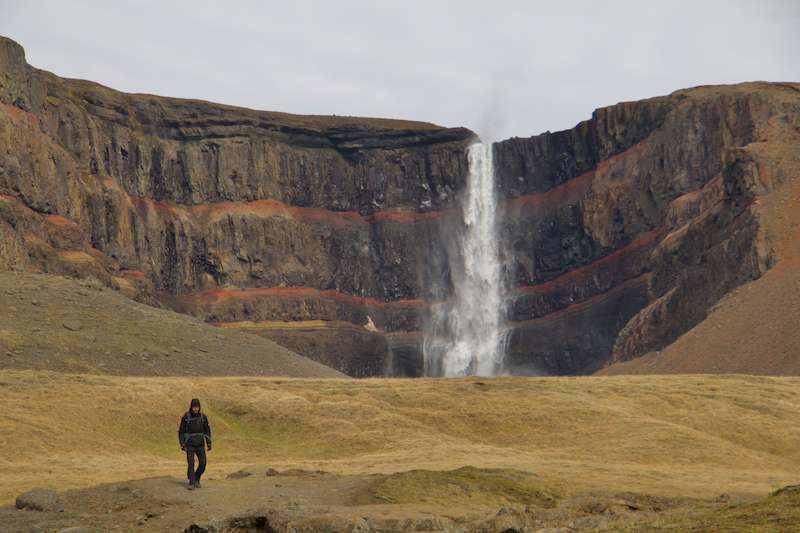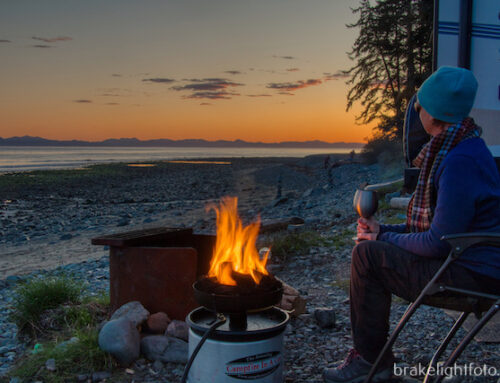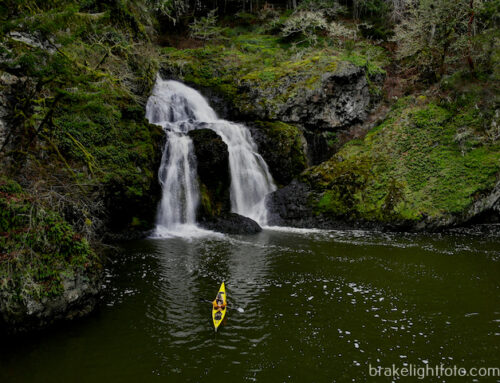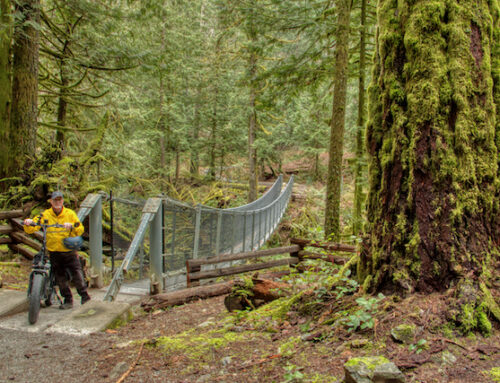Iceland – Hengifoss Waterfall & Egilsstaðir Day 8
Hengifoss Guesthouse has an awesome continental breakfast! It has all the usual stuff we’ve gotten used to in Iceland, but the owner also puts out her owned baked goods and homemade bread rolls. Delightful!! After stuffing our faces and drinking copious quantities of coffee we headed back down the road about 6 kilometres to Hengifoss waterfall.
Hengifoss
Hengifoss is the third highest waterfall in Iceland at 128 meters (420’) and it is surrounded by a horseshoe canyon made up of a strata of basalt with red layers of clay between the basaltic layers giving it very distinctive look.
The falls are visible from the road, but if you want to get closer you have to do the hike which is about 2.5 km each way taking about 2 hours. You can hike up to falls on one side of the canyon and come back down the other side which gives you some different views of the Hengifossá river gorge and the falls. We chose to climb up the left side of the falls leaving the parking lot climbing up a flight of stairs, which brought us to the gravel trail which was moderately steep, but not very difficult.
About half way up the trail we came to Litlanesfoss. This waterfall sits in a steep canyon with beautiful basalt columns similar to what we saw at Stuðlagil Canyon. You can walk right up to the edge for great views of the falls and canyon. I wanted to set up the tripod to get some blurred motion shots of the falls, but even using a weighted tripod, the wind had other ideas and I had to admit defeat yet again!
Once you reach the top of the canyon there are great views of Hengifoss. From here you can walk a bit further up the path towards the falls, but the path eventually ends and while you can scramble across the streams and rocks to get closer to the falls, we didn’t feel the need.
There is a bridge across the river at the top of the falls which allows you to hike back down the opposite side of the river for a different perspective on the canyon. It’s also not as steep and rough as the trail on the left side so it was an easier and safer route down, especially for Linda.
We were surprised to find a Pink-footed goose on the banks of the Hengifossá river! These geese are very common to Iceland and you see them everywhere, but this seemed a quite unusual spot!
Skriduklaustur
On the way back to the inn we stopped and walked around Skriduklaustur , the former farmstead and mansion of acclaimed Icelandic author Gunnar Gunnarsson, featuring exhibits & cafe – one of the visiting centers for the Vatnajökull National Park.
The ruins of a 16th-century monastery were also discovered here and the excavation site is in the fields down below the mansion.
Hallormsstaður National Forest
Since both of us are now trying to recover from our colds, we took the afternoon to just relax at the inn. We drove back in to Egilsstaðir for dinner following the road up the east side of the Lagarfjor lake, which is even more scenic than the west side since you drive through Hallormsstadur National Forest.
Hallormsstaður National Forest is considered to be Iceland‘s largest forest, with trees covering about 740 square kilometers. At the time of settlement, around 1100 years ago, Iceland was forested from the seashores to high up in the mountains. Over the centuries, the forests largely disappeared for a variety of reasons, including overgrazing by sheep. Volcanic eruptions and climate change have also taken their toll. However, through reforestation millions of trees are planted every year in Iceland and many of the forests are recovering.
A lot of Hallormsstaður is largely native birch, rowan and willow, but since 1905, the forest has been the site of large scale trials of other species and now includes species such as larch and red spruce. The forest is a popular outdoor recreation area with 11 marked trails. a couple of campsites and the Hotel Hallormsstadur is located in the forest.
Egilsstaðir
We found a funky little diner in Egilsstaðir, the Skálinn Diner, with rather colourful American 50’s style decor. It had standard diner fare of burgers, sandwiches, ice cream, milkshakes etc. Good food, but holy cow … once again it was approx $35 for Linda’s burger and about the same for the pita with chicken that I ordered!






















Leave A Comment